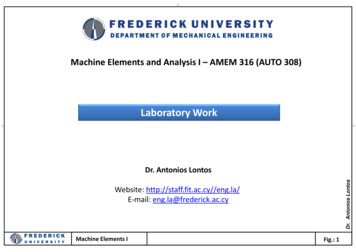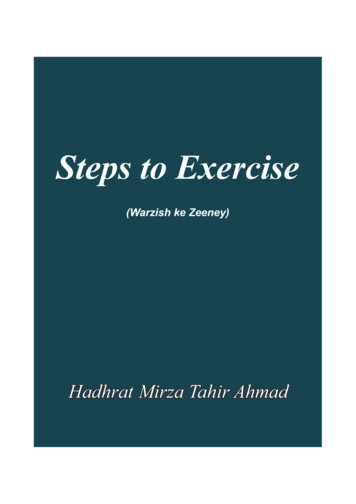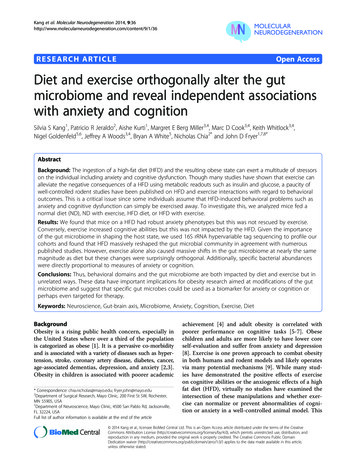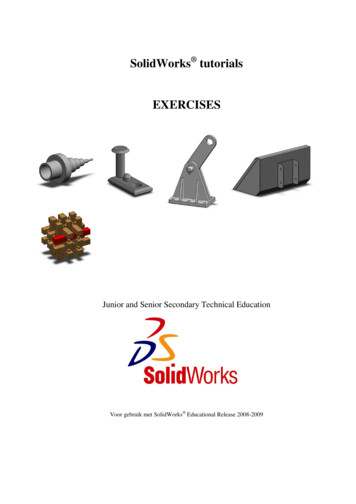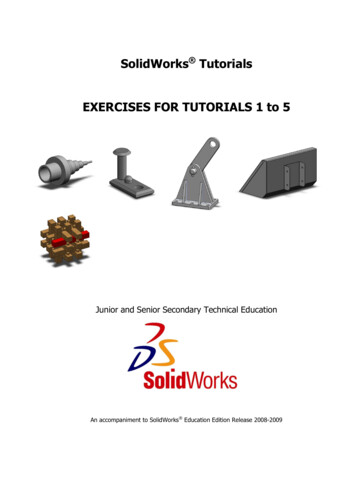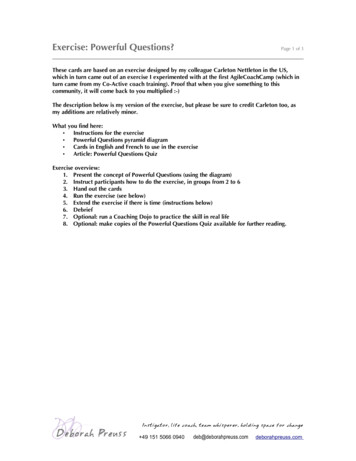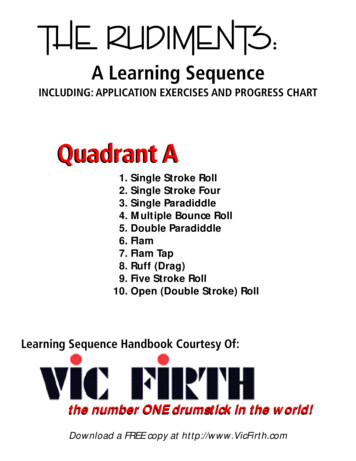
Transcription
Unit 14:Exercise, Health and LifestyleUnit code:T/502/5724QCF Level 3:BTEC NationalCredit value:10Guided learning hours: 60Aim and purposeThe aim of this unit is for learners to be able to assess the lifestyle of an individual and provide advice onlifestyle improvement.Unit introductionA healthy lifestyle is important in terms of quality of life. Individuals who take part in physical activity, eat ahealthy diet, don’t smoke, drink in moderation and manage their stress levels are likely to live longer and copebetter with the daily demands of life. Lifestyle plays a key role in the prevention of a large number of diseasesincluding coronary heart disease, cancer and obesity.This unit gives learners the knowledge and skills to assess the lifestyle of an individual, provide advice onlifestyle improvement and plan a health-related physical activity programme. The unit is particularly relevantfor individuals aiming to work in the exercise and fitness industry or in health promotion. Communicationskills, which are highly important in these areas of work, will be developed.The first part of the unit introduces learners to the importance of lifestyle in the maintenance of health andwellbeing. Learners will examine physical activity, alcohol consumption, smoking, diet and stress, looking athow each factor can affect the health of an individual. Guidelines for physical activity, recommendations foralcohol consumption, smoking cessation strategies, stress management techniques and dietary changes arecovered. Learners will also develop an understanding of behaviour change.The second part of the unit requires learners to assess the lifestyle of an individual and use the informationgathered to provide advice on lifestyle improvement. This includes planning a health-related physical activityprogramme.Learning outcomesOn completion of this unit a learner should:1Know the importance of lifestyle factors in the maintenance of health and wellbeing2Be able to assess the lifestyle of a selected individual3Be able to provide advice on lifestyle improvement4Be able to plan a health-related physical activity programme for a selected individual.Edexcel BTEC Level 3 Nationals specification in Sport– Issue 1 – January 2010 Edexcel Limited 20091
Unit content1 Know the importance of lifestyle factors in the maintenance of health and wellbeingLifestyle factors: physical activity recommendations and guidelines; benefits of physical activity; alcoholrecommendations and guidelines; risks associated with excessive drinking, eg stroke, cirrhosis,hypertension, depression; smoking – health risks, eg coronary heart disease, cancer, lung infections; stress– health risks, eg hypertension, angina, stroke, heart attack, ulcers; diet eg benefits of a healthy diet, effectsof poor nutrition, recommendations and guidelines2 Be able to assess the lifestyle of a selected individualLifestyle questionnaire: levels of physical activity; alcohol consumption; smoking; stress levels; dietConsultation: one-to-one consultation; communication, eg questioning, listening skills, non-verbalcommunication, client confidentiality3 Be able to provide advice on lifestyle improvementStrategies: ways to increase physical activity levels, eg walking, stair climbing, cycling; alcohol, eg seekalternatives, counselling and therapy, detoxification, self-help groups, alternative treatment and therapies;smoking, eg acupuncture, NHS smoking helpline, NHS stop-smoking services, nicotine replacementtherapy; stress management techniques, eg assertiveness, goal setting, time management, physical activity,positive self-talk, relaxation, breathing; diet, eg timing of food intake, eating more or less of certain foods,food preparation; behaviour change, eg stages of change, common barriers, cognitive and behaviouralstrategies4 Be able to plan a health-related physical activity programme for a selected individualCollect information: eg personal goals, lifestyle, medical history, physical activity history, attitudes,motivationGoal setting: goals (short-, medium- and long-term); SMART (specific, measurable, achievable, realistic,time bound) targetsPrinciples of training: overload; specificity; progression; individual differences; variation; reversibility; FITT(frequency, intensity, time and type) principlesAppropriate activities: eg walking, cycling, hiking, swimmingExercise intensity: eg rating of perceived exertion (RPE), maximum heart rate, maximum heart ratereserve, talk test2Edexcel BTEC Level 3 Nationals specification in Sport– Issue 1 – January 2010 Edexcel Limited 2009
Assessment and grading criteriaIn order to pass this unit, the evidence that the learner presents for assessment needs to demonstrate thatthey can meet all the learning outcomes for the unit. The assessment criteria for a pass grade describe thelevel of achievement required to pass this unit.Assessment and grading criteriaTo achieve a pass grade theevidence must show that thelearner is able to:To achieve a merit grade theevidence must show that, inaddition to the pass criteria,the learner is able to:To achieve a distinction gradethe evidence must show that,in addition to the pass andmerit criteria, the learner isable to:P1describe lifestyle factors thathave an effect on healthM1 explain the effects ofidentified lifestyle factors onhealthP2design and use a lifestylequestionnaire to describethe strengths and areas forimprovement in the lifestyleof a selected individual[IE1, IE2, CT1, CT2, RL1]M2 explain the strengths andareas for improvement inthe lifestyle of a selectedindividualD1evaluate the lifestyle ofa selected individual andprioritise areas for changeP3provide lifestyle improvement M3 explain recommendationsstrategies for a selectedmade regarding lifestyleindividualimprovement strategies.[CT3, EP3, EP4]D2analyse a range of lifestyleimprovement strategies.P4plan a six-week health-relatedphysical activity programmefor a selected individual.[CT3, CT5]PLTS: This summary references where applicable, in the square brackets, the elements of the personal,learning and thinking skills applicable in the pass criteria. It identifies opportunities for learners to demonstrateeffective application of the referenced elements of the skills.KeyIE – independent enquirersRL – reflective learnersSM – self-managersCT – creative thinkersTW – team workersEP – effective participatorsEdexcel BTEC Level 3 Nationals specification in Sport– Issue 1 – January 2010 Edexcel Limited 20093
Essential guidance for tutorsDeliveryThe unit should be introduced with the tutor identifying different lifestyle factors that affect health. There is awealth of information available and lifestyle factors could be investigated in greater depth by learners workingin groups. These groups should then feedback to the whole class on the information gained. Groups shouldbe briefed on the range of information they need to research. This includes national recommended physicalactivity guidelines, benefits of physical activity, recommendations for alcohol consumption, risks of excessivedrinking, health risks of smoking, benefits of a healthy diet and health risks associated with excessive stresslevels.Learners need to design and use a lifestyle assessment questionnaire for a selected client. Tutors shouldprovide a range of examples which can be reviewed. Questionnaires can be obtained from local healthclubs and are also published in a number of textbooks. Learners will then have a knowledge base that theycan use to devise their own questionnaires. Learners can complete the questionnaires, exchange themwith their peers and practise giving feedback to their peers. Learners need to conduct a one-to-one lifestyleconsultation. Tutors need to cover the format this should take, ensure learners demonstrate effectivecommunication skills and discuss the importance of client confidentiality. Learners can practise their skills whenworking with their peers in a role-play situation.Learners need to be able to give advice on lifestyle improvement. Tutors should cover a range of lifestyleimprovement strategies for; increasing physical activity, stopping smoking, reducing alcohol consumption,improving diet and managing stress. The area of behaviour change should also be introduced, with tutorsexplaining the stages of change, common barriers to change, and cognitive and behavioural strategies forinitiating change. Learners should then be given the opportunity to develop their knowledge and skills throughpractical activities and case studies.Linked to lifestyle improvement advice is the requirement for learners to plan a health-related physicalactivity programme. Prior to planning the physical activity programme, tutors should cover the theory behindprogramme design. Learners need to understand the principles of training, methods of monitoring intensity,and suitable activities for a health-related programme. The importance of collecting relevant information andof setting SMART targets also needs to be covered. Learners can develop their skills by planning a healthrelated exercise programme for individual case studies provided by tutors. A range of individuals with differentactivity levels should be covered to give a breadth of knowledge. Practical activities using pedometers can givelearners an appreciation of the amount of physical activity required for health benefits and the impact of smalllifestyle changes.4Edexcel BTEC Level 3 Nationals specification in Sport– Issue 1 – January 2010 Edexcel Limited 2009
Outline learning planThe outline learning plan has been included in this unit as guidance and can be used in conjunction with theprogramme of suggested assignments.The outline learning plan demonstrates one way in planning the delivery and assessment of this unit.Topic and suggested assignments/activities and/assessmentTutor introduces the unit and outlines the assessment.Assignment 1: Lifestyle and Health (P1, M1). Tutor introduces the assignment brief. Includes learner-initiatedprivate study.Physical activity recommendations and health benefits, alcohol recommendations, health risks of excessivedrinking, health risks of smoking, health risks of excessive stress, healthy eating – group research and feedback toclass. Includes learner initiated private study.Evaluation of personal lifestyle: individual evaluation of lifestyle including work completed in learners’ own time.Paired discussion.Increasing physical activity – practical activities using pedometers including learner activity completed in own time.Assignment 2: Lifestyle Improvement (P2, M2, D1, P3, M3, D2, P4). Tutor introduces the assignment brief.Includes learner initiated private study.Planning health-related exercise programmes – tutor introduces topic. Small-group case studies. Learners plan ahealth-related exercise programme for an individual, case studies provided. Feedback to class.Smoking cessation and ways to reduce alcohol consumption: tutor facilitates class discussion on strategies. Smallgroup activity making recommendations for scenarios provided and feedback to class.Stress management techniques: tutor-led practical activities covering time management, positive self talk,relaxation, breathing, assertiveness and goal setting.Dietary changes – tutor introduces topic. Small-group case studies. Learners make recommendations on how toimprove a diet based on food dietary information provided. Feedback to class.Behaviour change – tutor-led class discussion on behaviour change and strategies that can be used.Lifestyle questionnaire design – tutor introduces topic. Group evaluation of questionnaires and individual designof own questionnaire.Consultation skills – role play.Review of unit and assessment.Edexcel BTEC Level 3 Nationals specification in Sport– Issue 1 – January 2010 Edexcel Limited 20095
AssessmentFor P1, learners need to describe lifestyle factors that have an effect on health. Physical activity, alcoholconsumption, smoking, stress and diet must all be covered. Learners need to describe the benefits of physicalactivity, recommendations for alcohol consumption, health risks of excessive drinking, health risks of smoking,health risks of high stress levels and health risks of an unhealthy diet. Evidence could be in the form of awritten report or information booklet.Criteria P2, P3 and P4 lend themselves to being assessed together. For P2, learners need to collectinformation on the lifestyle of an individual using a self-designed questionnaire and one-to-one consultation.Learners should devise their own questionnaire and a copy of the completed version should be provided asassessment evidence. A completed tutor observation checklist would provide suitable evidence of the oneto-one consultation. Alternatively, video evidence would be acceptable, supported by a tutor observationrecord. For P3, learners need to provide lifestyle improvement strategies for a selected individual, includingadvice on stress management, smoking cessation, reducing alcohol consumption and dietary changeswhere appropriate. Evidence could be in the form of a written report or a record of a consultation with theindividual, for example an observation checklist or a video recording. For P4, learners need to plan a safeand effective six-week health-related physical activity programme for a selected individual. Ideally this shouldbe the individual on whom the lifestyle assessment has been done. A copy of the programme should bepresented as evidence. The principles of training should have been applied and the programme must besuitable for the individual’s needs and goals. It is also important that suitable activities have been selected and asuitable exercise intensity prescribed.Grading criterion M1 builds on P1, and requires learners to explain the effects of identified lifestyle factors onhealth. Physical activity, alcohol consumption, smoking, stress and diet need to be covered.For M2, which builds on P2, learners need to explain the strengths and areas for improvement of a selectedindividual’s lifestyle and explain recommended lifestyle improvement strategies. This could be best achievedin a written report. In order to explain the strengths and areas for improvement learners should comparephysical activity levels with national guidelines, compare alcohol consumption with national guidelines, assessstress levels, assess smoking habits and assess the diet of the individual against guidelines. Grading criterion M3builds on P3, and requires learners to explain recommendations made for lifestyle improvement strategies.These strategies should be explained in terms of their suitability for a particular individual.For D1, which builds on P2 and M2, learners need to evaluate the lifestyle of a selected individual and prioritiseareas for change. In doing this, they need to make some judgements about the strengths and areas forimprovement. For D2, which builds on P3 and M3, learners need to analyse a range of lifestyle improvementstrategies; this involves looking at the positives and negatives of different strategies and their impact.6Edexcel BTEC Level 3 Nationals specification in Sport– Issue 1 – January 2010 Edexcel Limited 2009
Programme of suggested assignmentsThe table below shows a programme of suggested assignments that cover the pass, merit and distinctioncriteria in the assessment and grading grid. This is for guidance and it is recommended that centres eitherwrite their own assignments or adapt any Edexcel assignments to meet local needs and resources.Criteria coveredAssignment titleScenarioAssessment methodP1, M1Lifestyle and HealthHaving gained employment asa health fitness instructor youexamine the lifestyle factorsthat have an effect on health.Information booklet.P2, P3, P4, M2,M3, D1, D2Lifestyle ImprovementWorking as a health fitnessinstructor involves carryingout lifestyle assessments forclients. Assess the lifestyle of anindividual and provide lifestyleimprovement strategies. Plan ahealth-related physical activityprogramme for the individual.Production of questionnaire.Practical observation andassessment of a clientconsultation.Observation record.Written health-related exerciseprogramme.Links to National Occupational Standards, other BTEC units, other BTECqualifications and other relevant units and qualificationsThis unit forms part of the BTEC Sport sector suite and the BTEC Sport and Exercise Sciences sector suite.This unit has particular links with the following unit titles in the BTEC Sport suite and the BTEC Sport andExercise Sciences suite:Level 2 SportLevel 3 SportLevel 3 Sport and ExerciseSciencesExercise and Fitness InstructionPrinciples of Anatomy andPhysiology in SportExercise for Specific GroupsDevelopment of Personal FitnessFitness Training and ProgrammingAnatomy for Sport and ExerciseNutrition for Sports PerformanceSports CoachingSport and Exercise PhysiologyLifestyle and the Sports PerformerThe Physiology of FitnessFitness Training and ProgrammingAnatomy and Physiology for SportInstructing Physical Activity andExerciseInstructing Physical Activity andExerciseSports NutritionApplied Sport and ExercisePhysiologyExercise for Specific GroupsSports CoachingThe Athlete’s LifestyleThis unit links with the National Occupational Standards (NOS) for: Instructing Physical Activity and Exercise at Level 3 Sports Development at Level 3 Coaching, Teaching and Instructing at Level 3 Achieving Excellence in Sports Performance at Level 3.Edexcel BTEC Level 3 Nationals specification in Sport– Issue 1 – January 2010 Edexcel Limited 20097
Essential resourcesLearners will need access to suitable facilities for conducting lifestyle analyses and access to suitable groupswho could be used as clients.Employer engagement and vocational contextsThis unit will provide learners with the background knowledge and skills needed to work in the exercise andfitness industry or health promotion. Centres are encouraged to develop links with local health and fitnesscentres and Primary Care Trusts (PCTs). This could be via talks, demonstrations, workshops or visits.Indicative reading for learnersTextbooksAmerican College of Sports Medicine – ACSM’s Guidelines for Exercise Testing and Prescription, 7th Edition(Lippincott Williams and Wilkins, 2005) ISBN 9780781745901Bird S R, Smith A and James K – Exercise Benefits and Prescription (Nelson Thornes, 1998)ISBN 9780748733156Coulson M – The Fitness Instructor’s Handbook: A Complete Guide to Health and Fitness – Fitness Professionals(A&C Black, 2007) ISBN 9780713682250Franks B D and Howley E T – Fitness Leader’s Handbook (Human Kinetics Europe, 1998)ISBN 9780880116541Heyward V H – Advanced Fitness Assessment and Exercise Prescription (Human Kinetics, 2006)ISBN 9780736057325Howley E T and Franks B D – Health Fitness Instructor’s Handbook (Human Kinetics Europe, 2003)ISBN 9780736042109Volpe S L et al – Fitness Nutrition for Special Dietary Needs (Human Kinetics Europe, 2007)ISBN 9780736048125JournalsAmerican College of Sport Medicine’s Health and Fitness JournalBritish Medical JournalHeathex SpecialistJournal of Physical Activity and HealthJournal of Sports Medicine and Physical FitnessWebsitesAmerican College of Sports Medicinewww.acsm.orgBritish Nutrition Foundationwww.nutrition.org.ukDepartment of Healthwww.doh.gov.ukFood Standards Agencywww.eatwell.gov.ukHuman Kineticswww.humankinetics.comThe World Health Organisationwww.who.intTop End Sportswww.topendsports.com8Edexcel BTEC Level 3 Nationals specification in Sport– Issue 1 – January 2010 Edexcel Limited 2009
Delivery of personal, learning and thinking skillsThe table below identifies the opportunities for personal, learning and thinking skills (PLTS) that have beenincluded within the pass assessment criteria of this unit.SkillWhen learners are Independent enquirersdesigning and using a lifestyle questionnaire to describe the strengths and areas forimprovement in the lifestyle of a selected individualCreative thinkersdesigning and using a lifestyle questionnaire to describe the strengths and areas forimprovement in the lifestyle of a selected individualproviding lifestyle improvement strategies for a selected individualplanning a six-week health-related physical activity programme for a selectedindividualReflective learnersdesigning and using a lifestyle questionnaire to describe the strengths and areas forimprovement in the lifestyle of a selected individualEffective participatorsproviding lifestyle improvement strategies for a selected individual.Although PLTS are identified within this unit as an inherent part of the assessment criteria, there are furtheropportunities to develop a range of PLTS through various approaches to teaching and learning.SkillWhen learners are Independent enquirersresearching lifestyle factors that have an effect on healthresearching lifestyle questionnairesCreative thinkerspractising providing lifestyle improvement strategiespractising describing strengths and areas for improvement in the lifestyle of anindividualReflective learnerspractising describing strengths and areas for improvement in the lifestyle of anindividualTeam workerspractising providing verbal lifestyle improvement strategiespractising using a lifestyle questionnaire to describe strengths and areas forimprovement for an individualSelf-managersproviding lifestyle improvement strategies for a selected individual.Edexcel BTEC Level 3 Nationals specification in Sport– Issue 1 – January 2010 Edexcel Limited 20099
Functional Skills – Level 2SkillWhen learners are ICT – Use ICT systemsSelect, interact with and use ICT systemsindependently for a complex task to meet avariety of needsresearching lifestyle factors that have an effect on healthdesigning a lifestyle questionnaireproducing a health-related physical activity programmeICT – Find and select informationSelect and use a variety of sources ofresearching lifestyle factors that have an effect on healthinformation independently for a complex taskdesigning a lifestyle questionnaireAccess, search for, select and use ICTresearching lifestyle factors that have an effect on healthbased information and evaluate its fitness fordesigning a lifestyle questionnairepurposeICT – Develop, present andcommunicate informationEnter, develop and format informationindependently to suit its meaning andpurpose including: text and tables images numbers recordsBring together information to suit contentand purposedescribing lifestyle factors that have an effect on healthdesigning a lifestyle questionnaireproducing a health-related physical activity programmedescribing lifestyle factors that have an effect on healthdesigning a lifestyle questionnaireproducing a health-related physical activity programmePresent information in ways that are fit forpurpose and audiencedescribing lifestyle factors that have an effect on healthdesigning a lifestyle questionnaireproducing a health-related physical activity programmeEnglishSpeaking and listening – make a range ofcontributions to discussions and makeeffective presentations in a wide range ofcontextscollecting information on the lifestyle of an individualReading – compare, select, read andunderstand texts and use them to gatherinformation, ideas, arguments and opinionsdescribing lifestyle factors that have an effect on healthWriting – write documents, includingextended writing pieces, communicatinginformation, ideas and opinions, effectivelyand persuasivelydescribing lifestyle factors that have an effect on health.10providing lifestyle improvement strategies for a selected individualdescribing the strengths and areas for improvement in the lifestyleof a selected individualEdexcel BTEC Level 3 Nationals specification in Sport– Issue 1 – January 2010 Edexcel Limited 2009
Learners need to design and use a lifestyle assessment questionnaire for a selected client. Tutors should provide a range of examples which can be reviewed. Questionnaires can be obtained from local health . Lifestyle questionnaire design - tutor introduces topic. Group evaluation of questionnaires and individual design of own questionnaire.

